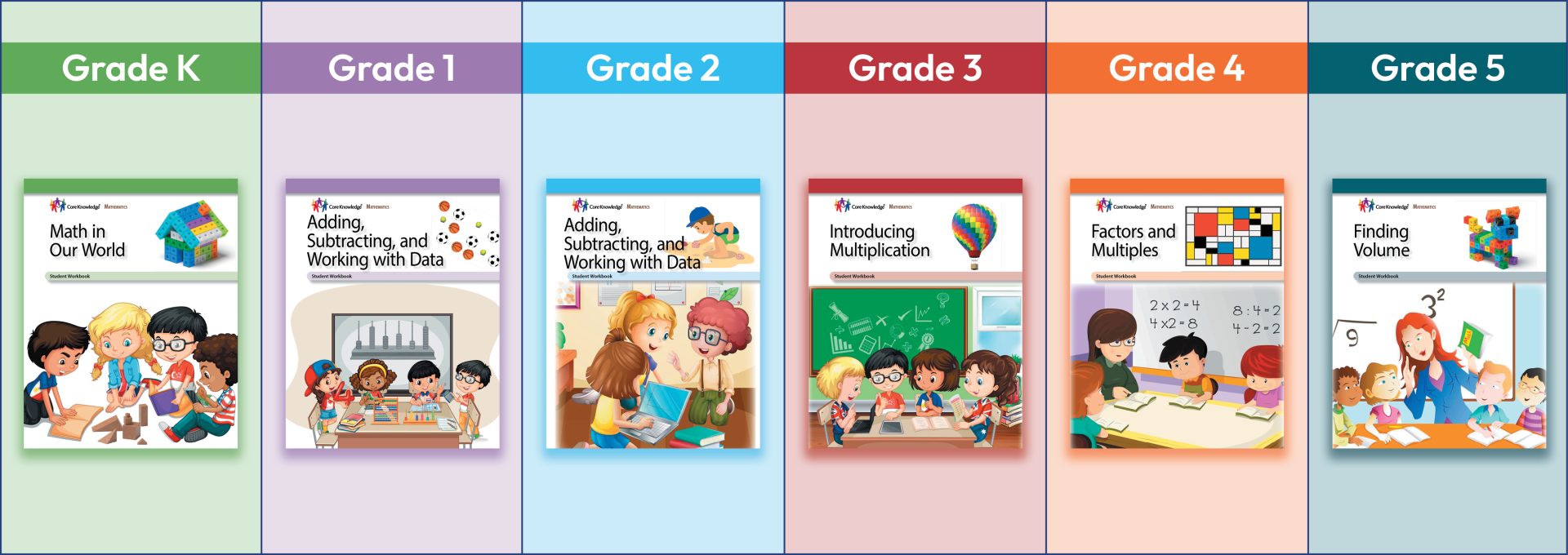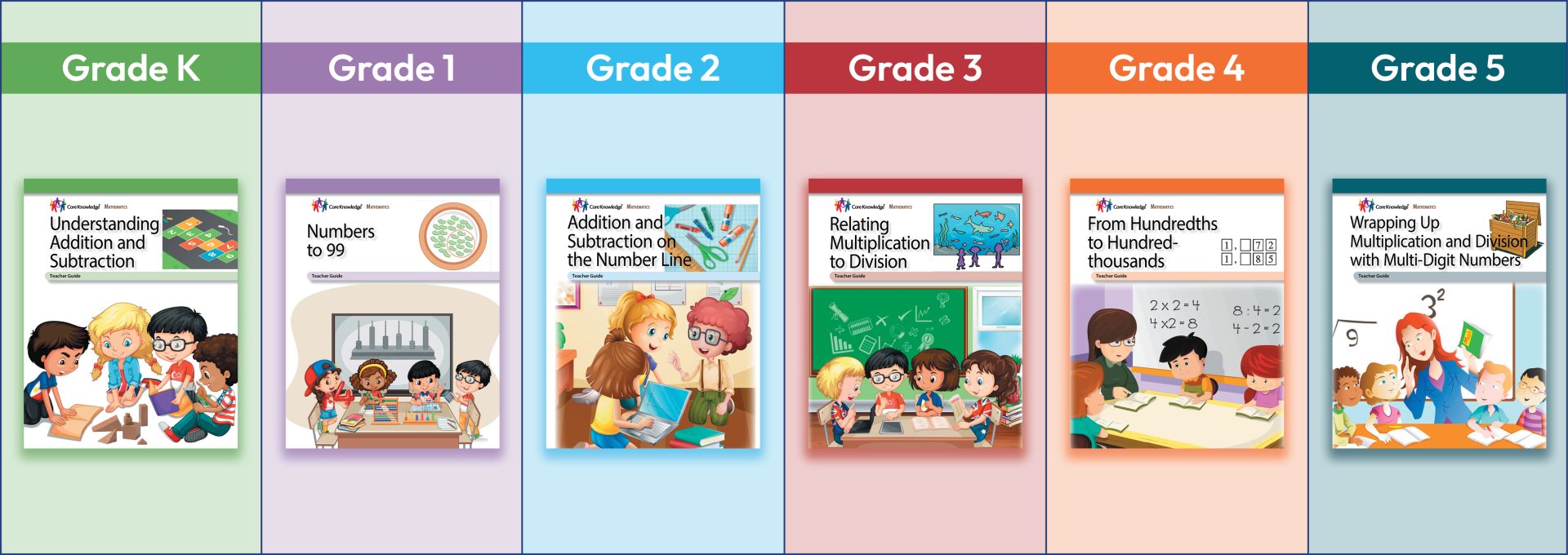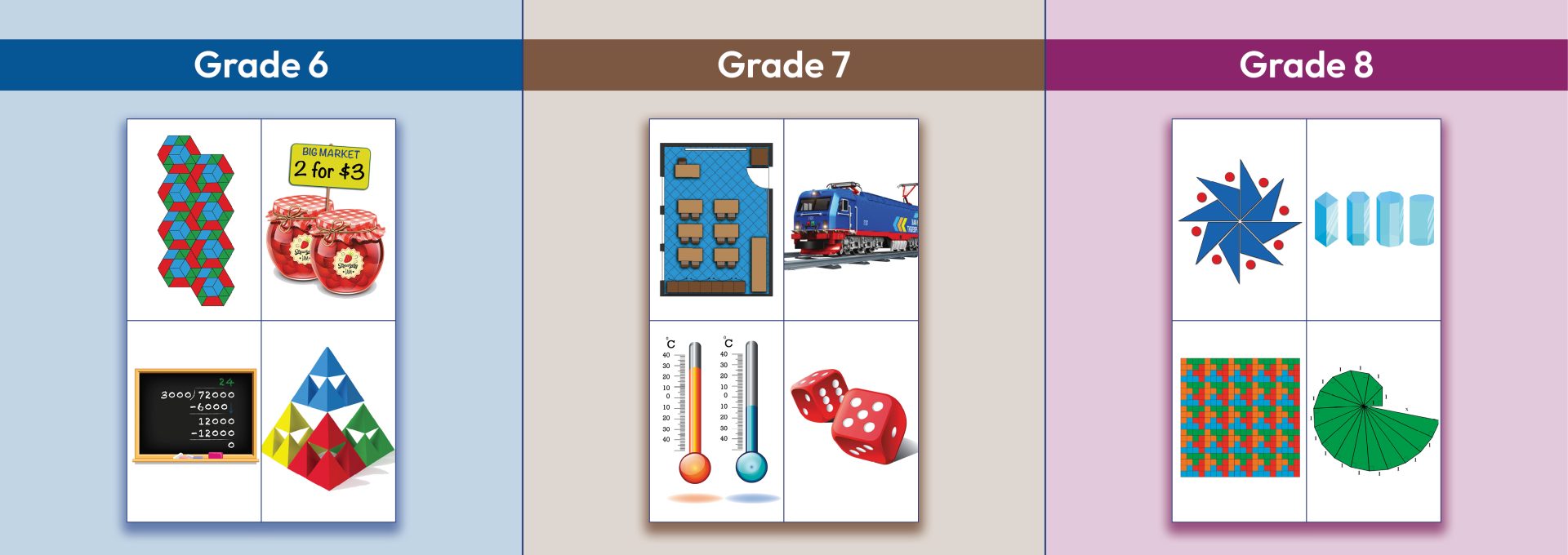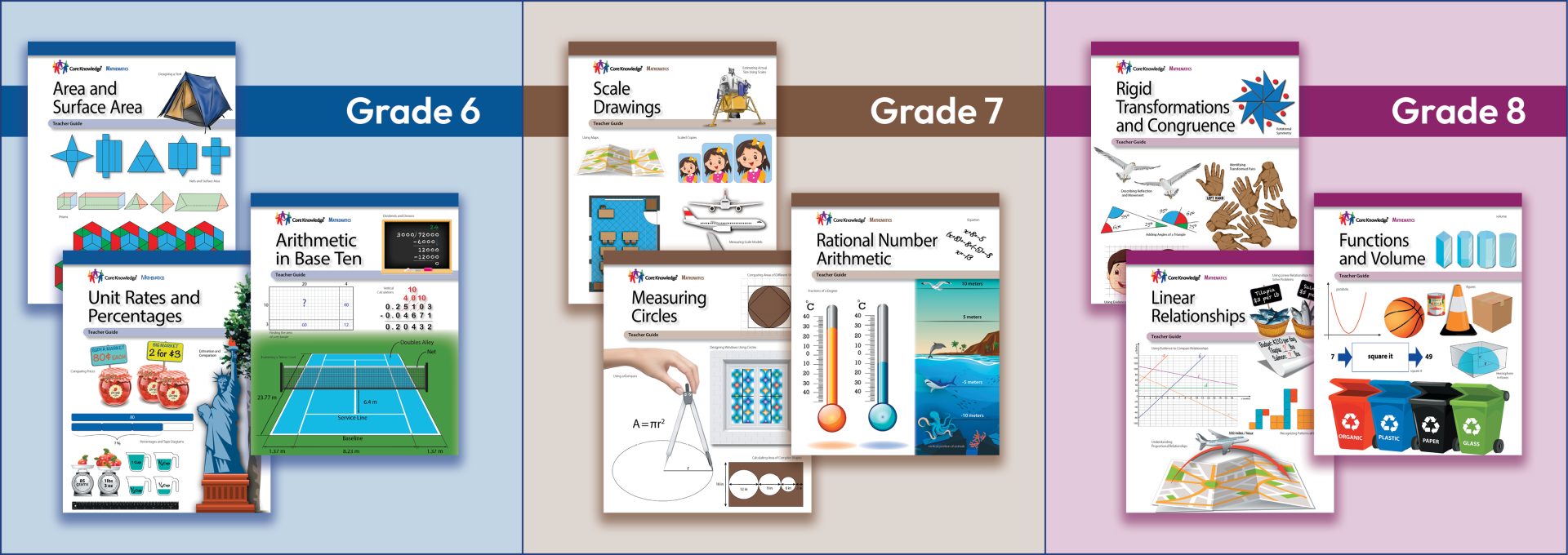Mathematics
Grades K–5
Core Knowledge Mathematics™ (CKMath™) is the newest subject-area to be added to the Core Knowledge Curriculum Series™. Based upon the highly-rated Illustrative Math and Open Up Resources OER curriculum, CKMath offers students the opportunity to develop conceptual understanding and procedural fluency while they work with an adult to apply math in the real world.
In these units, students take an active role in the learning process by building on their previous knowledge, and by exploration to develop conceptual understanding instead of being told how to solve problems. Doing math includes: understanding problems, reasoning abstractly and quantitatively, making arguments and critiquing the reasoning of others, modeling with mathematics, making appropriate use of tools, attending to precision in their use of language, looking for and making use of structure, and expressing regularity in repeated reasoning. Encouraging students to participate in mathematical practices with other students gives the opportunity for them to perceive themselves as mathematical thinkers and as part of a mathematical community. By observing students’ understanding of concepts and their thought processes, teachers are able to direct student learning and guide them to recognize the connection between concepts and procedures.

CKMath Workbooks contain the “Student Task Statements,” which are the activities for each lesson, and the “Cumulative Practice Problems” that allow students to build conceptual understanding and apply their knowledge and skills through distributed practice.

CKMath Teacher Guides include comprehensive lesson plans, assessments and answer keys for the unit, as well as printable teacher resources, including blackline masters and family take-home letters.

Grades 6–8
Core Knowledge Mathematics™ (CKMath™) is the newest subject-area to be added to the Core Knowledge Curriculum Series™, with our immediate focus on the middle grades in 6–8. Based upon the highly-rated Illustrative Math and Open Up Resources OER curriculum, CKMath offers students the opportunity to develop conceptual understanding and procedural fluency while they work with an adult to apply math in the real world.
In these units, students take an active role in the learning process by building on their previous knowledge, and by exploration to develop conceptual understanding instead of being told how to solve problems. Doing math includes: understanding problems, reasoning abstractly and quantitatively, making arguments and critiquing the reasoning of others, modeling with mathematics, making appropriate use of tools, attending to precision in their use of language, looking for and making use of structure, and expressing regularity in repeated reasoning. Encouraging students to participate in mathematical practices with other students gives the opportunity for them to perceive themselves as mathematical thinkers and as part of a mathematical community. By observing students’ understanding of concepts and their thought processes, teachers are able to direct student learning and guide them to recognize the connection between concepts and procedures.

CKMath Workbooks contain the “Student Task Statements,” which are the activities for each lesson, and the “Cumulative Practice Problems” that allow students to build conceptual understanding and apply their knowledge and skills through distributed practice.

CKMath Teacher Guides include comprehensive lesson plans, assessments and answer keys for the unit, as well as printable teacher resources, including blackline masters and family take-home letters.

The Design Principles of CKMath
Each CKMath unit begins with a pre-assessment that helps teachers gauge what students know about both prerequisite and upcoming concepts and skills, so they can make adjustments accordingly. The initial lesson in a unit is designed to activate prior knowledge and provide an easy entry to point to new concepts so that students at different levels of both mathematical and English language proficiency can engage productively in the work.
The unit design systematically introduces students to representations, contexts, concepts, language, and notation. Thus, as their learning progresses, they are able to:
- make connections between different representations and strategies
- consolidate their conceptual understanding
- see and understand more efficient methods of solving problems
This approach, along with the distributed practice problems, gives students ongoing practice, which also supports developing procedural proficiency.
Students have opportunities to make connections to real-world contexts throughout the CKMath materials. Frequently, carefully-chosen anchor contexts are used to motivate new mathematical concepts, and students have many opportunities to make connections between contexts and the concepts they are learning.
Additionally, most units conclude with a real-world application lesson, often titled the “Let’s Put It to Work” culminating task.
In some cases, students spend more time developing mathematical concepts before tackling more complex application problems, and the focus is on mathematical contexts. The first unit on geometry is an example of this, Grade 6 Unit 1 Area and Surface Area.
Selected activities throughout the curriculum are structured using Five Practices for Orchestrating Productive Mathematical Discussions (Smith & Stein, 2011), also described in Principles to Actions: Ensuring Mathematical Success for All (NCTM, 2014), and Intentional Talk: How to Structure and Lead Productive Mathematical Discussions (Kazemi & Hintz, 2014).
These activities include a presentation of a task or problem. Students first engage in independent think-time followed by partner or small-group work on the problem. The teacher circulates as students are working and notes groups using different approaches. Groups or individuals are selected in a specific, recommended sequence to share their approach with the class, and finally, the teacher leads a whole-class discussion to make connections and highlight important ideas.
In a productive mathematics class, students should not just learn about mathematics, they should do mathematics. This can be defined as engaging in the mathematical practices:
- making sense of problems,
- reasoning abstractly and quantitatively,
- making arguments and critiquing the reasoning of others,
- modeling with mathematics,
- making appropriate use of tools,
- attending to precision in their use of language,
- looking for and making use of structure, and
- expressing regularity in repeated reasoning.
Students should take an active role, both individually and in groups, to see what they can figure out before having things explained to them or being told what to do. Teachers play a critical role in mediating student learning, but that role looks different than simply showing, telling, and correcting. The teacher’s role is to:
- ensure students understand the context and what is being asked,
- ask questions to advance students’ thinking in productive ways,
- help students share their work and understand others’ work through orchestrating productive discussions, and
- synthesize the learning with students at the end of activities and lessons.
With CKMath, teachers have comprehensive resources and lesson plans to assist their students to do mathematics in a problem-based learning environment.
More About CKMath
Collaboration
The Core Knowledge Mathematics™ curriculum is based upon materials created by Illustrative Mathematics in collaboration with Open Up Resources, which were originally published under a Creative Commons Attribution License: Creative Commons Attribution 4.0 International License (CC BY 4.0). The Core Knowledge Mathematics materials include the Illustrative Math enhancements (also licensed under CC BY 4.0) such as additional English language learner supports, item-by-item guidance for how to use the Check Your Readiness pre-assessment results, and more.
Vocabulary & Patterns
In grades K–5, mathematics has its own vocabulary and patterns of thinking. It is a discipline with its own
language and conventions. From the earliest years, mathematics requires incremental review and steady practice: not only the diligent effort required to master basic facts and operations, but also thoughtful and varied practice that approaches problems from a variety of angles, and gives children a variety of opportunities to apply the same concept or operation in different types of situations.
Concepts & Procedures
In grades 6-8, by learning the new concepts and procedures, students should use previously acquired
mathematics to ensure that the procedures become automatic and habitual. While teaching methods may vary, it is worth keeping in mind the psychological principle that the most effective method for learning mathematics emphasizes frequent, varied practice, and encourages multiple
approaches to solving varied types of problems.
Content & Practice Standards
CKMath is rooted in content and practice standards to foster learning and achievement for all. Students learn by doing math through solving problems, developing conceptual understanding, and discussing and defending their reasoning. Teachers build confidence with lessons and curriculum supports that help them facilitate learning and help students make connections between concepts and procedures.
More About CKMath
The Core Knowledge Mathematics™ curriculum is based upon materials created by Illustrative Mathematics in collaboration with Open Up Resources, which were originally published under a Creative Commons Attribution License: Creative Commons Attribution 4.0 International License (CC BY 4.0). The Open Up Resources curriculum was piloted and revised in the 2016–2017 school year. Further revisions were made in 2019 by Illustrative Mathematics and the open-source curriculum has continued to be highly rated by reviewers such as EdReports.org. The Core Knowledge Mathematics materials include the Illustrative Math enhancements (also licensed under CC BY 4.0) such as additional English language learner supports, item-by-item guidance for how to use the Check Your Readiness pre-assessment results, and more.
